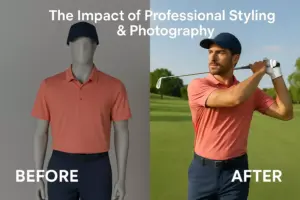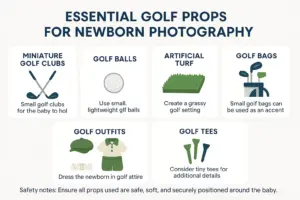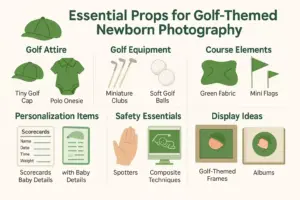How to Master the Drama of Black & White Golf Course Photography
The rolling fairways, pristine bunkers, and manicured greens of golf courses offer some of the most visually compelling landscapes for photographers. When these scenes are captured in black and white, they transform into dramatic studies of light, shadow, texture, and form. The absence of color strips away distractions, revealing the pure architectural brilliance of golf course design and the natural beauty of the landscape. In 2025, as digital photography continues to evolve, mastering black and white golf course photography has become both an art form and a technical challenge worth pursuing.
Key Takeaways
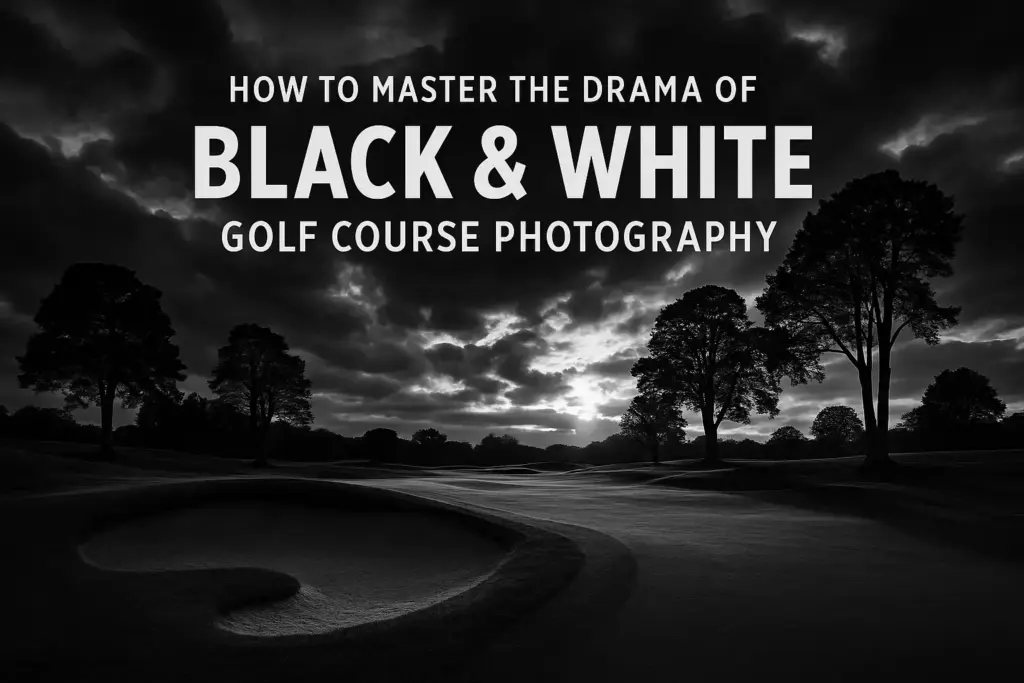
- Light quality is paramount – early morning and late afternoon golden hours create the dramatic shadows and highlights essential for impactful black and white golf course photography
- Composition techniques like leading lines (using fairways and paths) and framing (with trees and bunkers) create powerful black and white images
- Weather conditions significantly impact black and white photography – cloudy days provide even contrast while stormy skies add drama
- Post-processing skills in adjusting contrast, clarity, and selective dodging/burning are essential for creating powerful monochromatic golf course images
- Technical equipment choices matter – polarizing filters, graduated ND filters, and tripods are invaluable tools for capturing the full tonal range of the course
Understanding the Appeal of Black & White Golf Course Photography
There’s something timeless about black and white photography that resonates with viewers on a deeper level. When applied to golf course landscapes, this medium strips away the distraction of color and focuses attention on the fundamental elements that make these spaces so visually compelling.
The Timeless Quality of Monochrome
Black and white photography has endured for good reason. It emphasizes form, texture, pattern, and light in ways color photography cannot. On a golf course, the absence of color highlights:
- The graceful contours of fairways and greens
- The stark contrast between bunkers and surrounding grass
- The textural details of rough grasses and tree bark
- The architectural lines of clubhouses and bridges
- The dramatic play of light and shadow across the landscape
This timeless aesthetic connects modern golf course photography with the rich history of the sport, creating images that feel both contemporary and classic.
Why Golf Courses Make Perfect Black & White Subjects
Golf courses are uniquely suited to black and white photography for several reasons:
- Built-in contrast – The natural contrast between light sand bunkers, dark trees, and mid-toned grass creates instant visual interest
- Strong geometric patterns – Fairways, bunkers, and greens create natural leading lines and shapes
- Textural variety – From smooth greens to rippled sand and rough grasses
- Dramatic lighting opportunities – Open spaces allow for stunning light play across the landscape
- Architectural elements – Clubhouses, bridges, and other structures add human-scale interest
These inherent qualities make golf courses ideal subjects for photographers looking to create compelling black and white images with depth and visual impact.
Essential Equipment for Black & White Golf Course Photography
While skill and vision are paramount, having the right equipment will significantly enhance your ability to capture stunning black and white golf course photographs.
Camera Selection and Settings
Camera Bodies:
Any modern digital camera can produce excellent black and white images, but certain features prove particularly valuable:
- High dynamic range cameras help capture both shadow and highlight detail
- Weather-sealed bodies protect your investment during early morning dew or unexpected weather
- Electronic viewfinders allow you to preview in black and white while shooting
Recommended Settings:
- File format: Shoot in RAW for maximum post-processing flexibility
- ISO: Keep as low as possible (100-400) to minimize noise
- White balance: While ultimately irrelevant for B&W, a consistent setting helps visualization
- Picture style: Many cameras offer B&W preview modes that help visualize the final image
“The best camera for black and white golf course photography is the one that becomes invisible in your hands, allowing you to focus entirely on composition and light.” – Professional golf course photographer
Lens Selection for Maximum Impact
Different focal lengths create dramatically different effects in black and white golf course photography:
| Lens Type | Focal Range | Best Used For | Effect on B&W Images |
|---|---|---|---|
| Wide-angle | 14-35mm | Dramatic landscapes, emphasizing foreground elements | Exaggerates perspective, highlights leading lines |
| Standard | 35-70mm | Natural perspective, balanced compositions | Closest to human vision, creates relatable images |
| Telephoto | 70-200mm+ | Compressing distance, isolating elements | Compresses layers, emphasizes texture and patterns |
Prime lenses (fixed focal length) often deliver superior sharpness and wider apertures, which can be beneficial for creating images with selective focus and enhanced detail.
Essential Filters and Accessories
Several accessories prove invaluable for black and white golf course photography:
- Polarizing filter – Reduces glare, darkens skies, and increases contrast
- Graduated neutral density filters – Balance exposure between bright skies and darker foregrounds
- Solid neutral density filters – Allow for longer exposures to blur moving clouds or water
- Sturdy tripod – Essential for low-light conditions and precise compositions
- Remote shutter release – Minimizes camera shake during longer exposures
- Extra batteries and memory cards – Critical for early morning or all-day shoots
📱 Mobile apps like PhotoPills or The Photographer’s Ephemeris help plan shoots around optimal lighting conditions, showing exactly where the sun will rise and set relative to your location.
Mastering Light and Composition
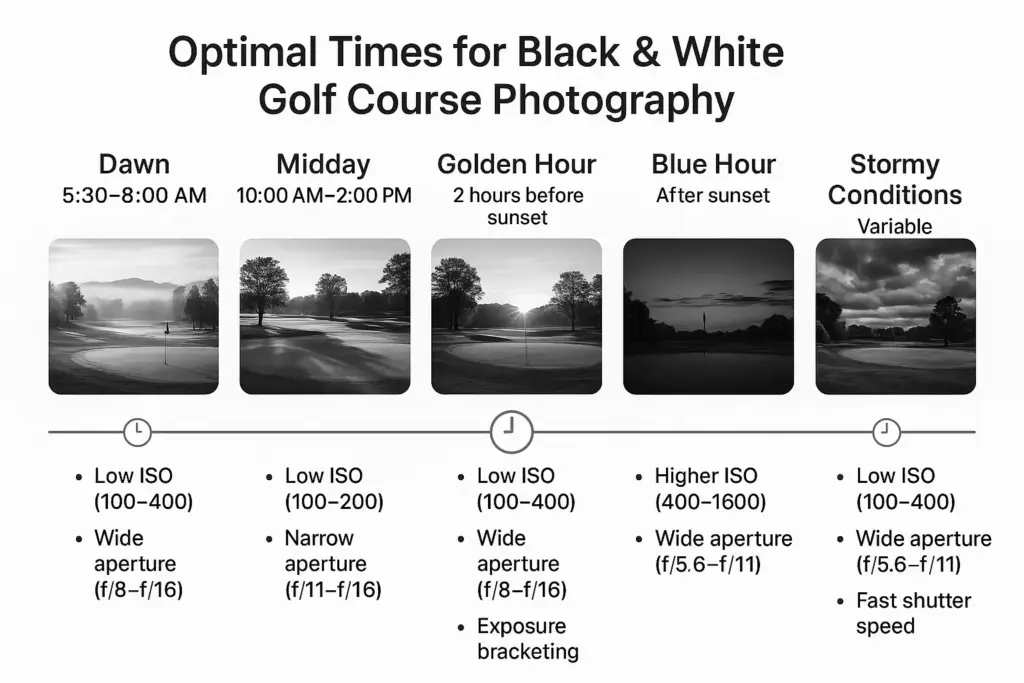
The foundation of powerful black and white golf course photography lies in understanding how to work with light and compose images that maximize visual impact.
The Decisive Role of Light in Black & White Photography
In color photography, vibrant hues can sometimes compensate for mediocre lighting. In black and white, light quality becomes absolutely critical. Consider these lighting scenarios:
- Early morning light – Creates long shadows, revealing texture and form while adding drama
- Midday light – Generally harsh but can work well for high-contrast, minimalist compositions
- Golden hour – Provides warm, directional light that sculpts the landscape
- Blue hour – Creates mysterious, moody atmospheres with subtle tonal gradations
- Overcast conditions – Offers soft, diffused light that reveals subtle details and textures
Side lighting is particularly effective for black and white golf course photography as it reveals texture and creates dimensional shadows that add depth to the image.
Composition Techniques Specific to Golf Courses
Golf courses offer unique compositional opportunities that can be leveraged for striking black and white images:
- Leading lines – Use fairways, cart paths, or rows of trees to draw the viewer through the frame
- Framing – Position overhanging branches, bunker edges, or architectural elements to frame the primary subject
- Layering – Incorporate foreground, middle ground, and background elements to create depth
- Rule of thirds – Place key elements like flagsticks, bunkers, or horizon lines at intersection points
- Negative space – Utilize open skies or expanses of fairway to create breathing room around focal points
🔍 Pro tip: Look for opportunities to incorporate reflections in water hazards or morning dew to add another dimension to your compositions.
Weather Conditions and Their Impact
Different weather conditions dramatically affect the mood and character of black and white golf course photographs:
- Clear skies – Create high-contrast images with strong shadows
- Partly cloudy – Offer dynamic skies with interesting cloud formations
- Overcast – Provide soft, even lighting that reveals subtle textures
- Stormy conditions – Create dramatic, moody atmospheres with dynamic skies
- Fog or mist – Produces ethereal, minimalist images with a sense of mystery
Seasonal changes also significantly impact black and white photography. Winter’s bare trees create graphic elements, while summer’s lush growth offers textural richness. Spring and fall transitions provide unique opportunities to capture the landscape in flux.
Advanced Shooting Techniques
Moving beyond the basics requires mastering specialized techniques that can elevate your black and white golf course photography to professional levels.
Capturing Dramatic Skies and Cloud Formations
The sky often becomes a dominant element in black and white golf course photography. To maximize its impact:
- Use graduated ND filters to balance exposure between bright skies and darker foregrounds
- Incorporate a polarizing filter to darken blue skies and make clouds pop
- Consider long exposures (30 seconds to several minutes) to create streaking cloud effects
- Experiment with infrared photography for surreal, dramatic skies with dark tones
- Position the horizon line strategically – lower in the frame to emphasize dramatic skies
Highlighting Texture and Pattern
Black and white photography excels at revealing texture and pattern. On golf courses, look for:
- Mowing patterns on fairways and greens
- Ripples in sand bunkers
- Bark texture on feature trees
- Architectural details on clubhouses and bridges
- Shadow patterns created by trees or structures
Close-up photography with longer focal lengths can isolate these textural elements, creating abstract compositions that reveal the subtle beauty of the golf course landscape.
Creating Mood and Atmosphere
The emotional impact of black and white golf course photography often comes from successfully capturing mood and atmosphere:
- Dawn photography – Captures the tranquility of the course before play begins, often with mist or dew
- Twilight shooting – Creates mysterious, moody images as light fades
- Stormy conditions – Generates dramatic tension with threatening skies
- Backlighting – Produces silhouettes and rim lighting for dramatic effect
- Seasonal elements – Incorporates frost, fallen leaves, or seasonal blooms
Exposure techniques like intentional underexposure can enhance mood, creating darker, more mysterious images that convey emotional weight.
Post-Processing for Impact
The digital darkroom is where black and white golf course photographs truly come to life. Thoughtful post-processing transforms good images into great ones.
Essential Software and Tools
Several software options exist for processing black and white golf course photography:
- Adobe Lightroom Classic – Excellent for organizing and basic adjustments
- Adobe Photoshop – Provides advanced editing capabilities and layered adjustments
- Capture One – Known for superior raw file handling and tonal adjustments
- Silver Efex Pro (part of the Nik Collection) – Specialized black and white conversion tool
- Exposure X7 – Offers film emulation presets and powerful local adjustments
For those seeking a more traditional approach, film emulation presets can provide starting points that mimic classic black and white films like Kodak Tri-X, Ilford HP5, or Agfa APX.
Black and White Conversion Techniques
Converting a color image to black and white is far more nuanced than simply desaturating. Consider these approaches:
- Channel mixer adjustments – Selectively control how each color translates to grayscale
- Black and white adjustment layers – Provide sliders to adjust how individual colors convert
- Gradient maps – Offer precise control over tonal mapping
- Specialized plugins – Tools like Silver Efex Pro provide sophisticated conversion options
The goal is to create separation between elements that might have had similar luminosity values but different colors in the original scene.
Contrast, Clarity, and Dodging & Burning
After conversion, these techniques bring your black and white golf course images to life:
- Global contrast adjustments – Set the overall tonal range of the image
- Local contrast (clarity) – Enhances texture and detail in mid-tones
- Dodging and burning – Selectively lighten or darken specific areas to guide the viewer’s eye
- Vignetting – Subtly darkens corners to focus attention on the central subject
- Toning – Adds subtle color (sepia, selenium, etc.) for warmth or coolness
⚡ Advanced technique: Create luminosity masks to target adjustments to specific tonal ranges (shadows, mid-tones, or highlights) for precise control over the final image.
Creating a Consistent Style
Developing a recognizable style sets your black and white golf course photography apart:
- Consistent contrast range – Establish whether you prefer high-contrast or more subtle tonal gradations
- Signature toning – Apply consistent subtle color tints across your portfolio
- Recognizable compositions – Develop compositional approaches that become your trademark
- Processing presets – Create custom presets that apply your preferred adjustments
- Printing techniques – Consider how your images will be displayed, as print media affects perception
Many professional photographers create processing recipes that they apply consistently, making their work instantly recognizable.
Practical Shooting Scenarios and Solutions
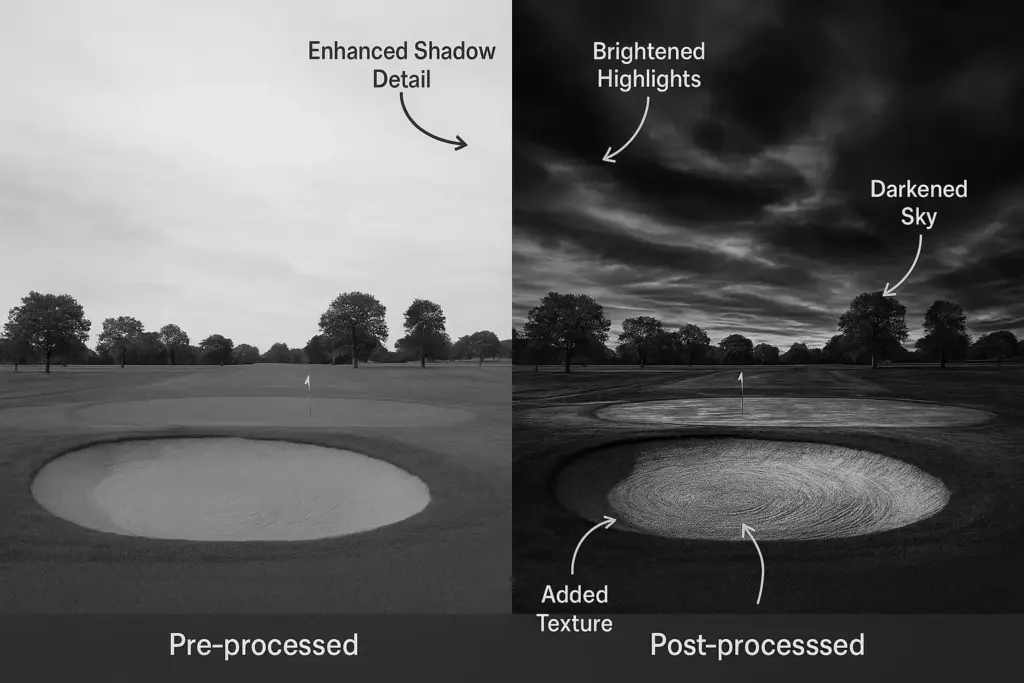
Different areas of the golf course present unique challenges and opportunities for black and white photography. Here’s how to approach each scenario.
Tee Boxes and Fairways
Tee boxes and fairways offer sweeping vistas and strong directional elements:
Challenges:
- Large open spaces can lack focal points
- Flat lighting can make fairways appear one-dimensional
Solutions:
- Use morning or evening light to create long shadows across mown patterns
- Incorporate players or maintenance staff for scale and human interest
- Position yourself to capture leading lines that draw the eye through the frame
- Look for opportunities to shoot from elevated positions for more dramatic perspectives
Bunkers and Hazards
Sand bunkers and water hazards provide natural contrast elements:
Challenges:
- Extreme brightness of sand can lead to blown highlights
- Water reflections can be difficult to expose properly
Solutions:
- Bracket exposures or use graduated filters to balance bright sand with darker surroundings
- Visit bunkers after rain when wet sand offers more textural detail
- Shoot water hazards during calm conditions for mirror-like reflections
- Use polarizing filters to control glare and reflection intensity
Greens and Pin Placements
Greens offer subtle contours and geometric possibilities:
Challenges:
- Subtle undulations can disappear in flat light
- Greens can appear as featureless gray areas without proper technique
Solutions:
- Shoot during low-angle light to reveal contours through shadows
- Include flags as vertical elements and focal points
- Get low to emphasize green contours against the sky
- Look for opportunities to capture maintenance activities like mowing or hole cutting
Clubhouses and Architectural Elements
Man-made structures provide scale and historical context:
Challenges:
- Modern clubhouses may lack character in black and white
- Architectural details can be lost without proper lighting
Solutions:
- Shoot historic clubhouses during golden hour for warm, directional light
- Use wide-angle lenses to emphasize dramatic perspectives
- Include environmental elements like approaching storms for added drama
- Look for opportunities to silhouette structures against bright skies
Seasonal Considerations
Each season offers unique opportunities for black and white golf course photography.
Spring: Renewal and Contrast
Spring brings fresh growth and atmospheric conditions ideal for black and white photography:
- Morning mist creates ethereal scenes as the landscape awakens
- New growth provides subtle textural elements
- Spring storms deliver dramatic skies and lighting conditions
- Maintenance activities like aeration and overseeding create interesting patterns
The contrast between maintained areas and natural spring growth creates compelling visual tension.
Summer: Light and Shadow Play
Summer’s long days and high sun position create unique opportunities:
- Early morning light before play begins offers tranquil scenes
- Dramatic thunderstorms provide spectacular cloud formations
- Lush growth creates maximum textural contrast
- Long evening shadows stretch across fairways and greens
The challenge becomes managing harsh midday light, making early morning and evening the prime shooting times.
Fall: Texture and Atmosphere
Autumn brings some of the most dramatic conditions for black and white golf course photography:
- Morning frost creates sparkling highlights across the landscape
- Fog and mist are more common, adding atmosphere
- Fallen leaves provide textural elements and contrast
- Lower sun angles throughout the day extend prime shooting hours
The transition from summer maintenance to winter preparation creates visually interesting scenes.
Winter: Minimalism and Graphic Elements
Winter strips the golf course to its essential elements, perfect for minimalist black and white photography:
- Snow coverage creates high-contrast scenes with strong graphic qualities
- Bare trees become sculptural elements against bright skies
- Frost patterns add delicate texture to otherwise simple compositions
- Long shadows extend across the landscape throughout the shorter days
Winter’s harsh conditions can create the most dramatic and emotionally powerful black and white golf course images.
Building a Portfolio and Finding Your Voice
As you develop your skills in black and white golf course photography, consider how to build a cohesive body of work.
Developing Projects with Thematic Coherence
Rather than random beautiful images, consider developing projects with thematic focus:
- Single course through the seasons – Document one course as it changes throughout the year
- Architectural studies – Focus on the design elements of different courses
- Environmental portrait series – Capture the people who maintain and play the courses
- Abstract details – Create a collection focusing on patterns, textures, and graphic elements
- Historic courses – Document courses with significant historical importance
These thematic approaches create bodies of work with greater depth and meaning than isolated images.
Sharing and Exhibiting Your Work
Once you’ve created compelling black and white golf course photographs, consider these avenues for sharing:
- Social media platforms like Instagram and specialized golf photography communities
- Golf club exhibitions – Approach clubs about displaying work in their facilities
- Golf publications – Submit images to magazines and websites focused on the sport
- Fine art prints – Create limited edition prints for collectors and enthusiasts
- Photo books – Self-publish collections of your work through services like Blurb
Many golf clubs and resorts are constantly seeking fresh imagery for their marketing materials, creating potential commercial opportunities.
Ethical Considerations and Access
Golf course photography comes with specific ethical considerations:
- Always obtain permission before photographing private courses
- Respect play by shooting during off-hours or from positions that don’t disturb golfers
- Follow cart path and access rules established by the course
- Consider offering images to courses in exchange for access
- Obtain model releases when including identifiable people in commercial work
Building relationships with course superintendents and club professionals can provide valuable access opportunities and insider knowledge about the best photographic locations.
Conclusion
Black and white photography transforms golf courses from mere sporting venues into artistic landscapes of light, shadow, texture, and form. By mastering the technical aspects of equipment selection, understanding the critical importance of light and composition, and developing your post-processing skills, you can create compelling images that reveal the dramatic beauty of these carefully designed landscapes.
The journey to mastering black and white golf course photography is ongoing. Each season, each weather condition, and each time of day offers new possibilities to see these familiar spaces in fresh ways. The most successful photographers develop a personal vision and style that transcends mere documentation, creating images that evoke emotional responses and reveal unseen beauty.
As you continue developing your skills, remember that the most powerful black and white golf course photographs come not just from technical proficiency but from a deep appreciation for the landscape and a willingness to return to the same locations repeatedly under different conditions. Patience, persistence, and a keen eye for the interplay of light and shadow will ultimately lead to images that capture the true drama and beauty of these special places.
Next steps:
- Select a local golf course and commit to photographing it through all seasons
- Experiment with different times of day to understand how light transforms the landscape
- Develop a consistent post-processing workflow that reflects your personal vision
- Create a portfolio of your best work and share it with the golf community
- Consider entering golf landscape photography competitions to gain exposure
Black & White Golf Course Photography Interactive Guide
Select a lighting condition to see optimal camera settings and composition tips
Dawn/Early Morning (5:30-8:00 AM)
The soft, directional light of early morning creates long shadows and reveals texture across the golf course. Morning mist and dew add atmospheric elements.
| Camera Setting | Recommendation | Notes |
|---|---|---|
| Aperture | f/8 – f/11 | Provides good depth of field while maintaining sharpness |
| Shutter Speed | 1/60 – 1/125 sec | Use tripod if below 1/60 sec in low light |
| ISO | 100-400 | Higher in deep shadows or heavy mist |
| White Balance | Daylight/5500K | Creates cooler tones that convert well to B&W |
| Filters | Polarizer, Graduated ND | Polarizer cuts glare from dew; Grad ND balances bright sky |
Midday (10:00 AM – 2:00 PM)
Typically avoided by photographers, midday light can create high-contrast, minimalist images when approached correctly.
| Camera Setting | Recommendation | Notes |
|---|---|---|
| Aperture | f/11 – f/16 | Smaller aperture to handle bright conditions |
| Shutter Speed | 1/125 – 1/500 sec | Fast enough to handle any breeze |
| ISO | 100 | Lowest native ISO for maximum quality |
| White Balance | Daylight/5500K | Standard setting for midday sun |
| Filters | Polarizer, ND | Polarizer to deepen skies; ND to allow longer exposures |
Golden Hour (1-2 hours before sunset)
The warm, directional light of golden hour creates a magical atmosphere with rich shadows and highlights.
| Camera Setting | Recommendation | Notes |
|---|---|---|
| Aperture | f/8 – f/11 | Good balance of depth of field and sharpness |
| Shutter Speed | 1/60 – 1/250 sec | Adjust as light levels change rapidly |
| ISO | 100-400 | Increase as light fades |
| White Balance | Cloudy/6500K | Enhances warmth that translates to rich tones in B&W |
| Filters | Graduated ND, Polarizer | Grad ND essential for balancing bright sky with darker foreground |
Overcast/Cloudy Conditions
Soft, diffused light that reveals subtle textures and tonal gradations without harsh shadows.
| Camera Setting | Recommendation | Notes |
|---|---|---|
| Aperture | f/5.6 – f/8 | Can open up more in diffused light |
| Shutter Speed | 1/60 – 1/125 sec | May need slower speeds in heavy overcast |
| ISO | 200-800 | Higher than bright conditions |
| White Balance | Cloudy/6500K | Counteracts the bluish cast of overcast days |
| Filters | Polarizer | Still useful for cutting glare and increasing contrast |
Stormy Conditions
Dramatic skies and changing light create moody, emotional images with high visual impact.
| Camera Setting | Recommendation | Notes |
|---|---|---|
| Aperture | f/8 – f/11 | Good depth of field for dramatic landscapes |
| Shutter Speed | 1/60 – 1/250 sec | Faster speeds may be needed in windy conditions |
| ISO | 200-800 | Higher for darker storm clouds |
| White Balance | Cloudy/6500K | Adds warmth to otherwise cool stormy light |
| Filters | Graduated ND, Polarizer | Essential for balancing dramatic skies with foreground |

